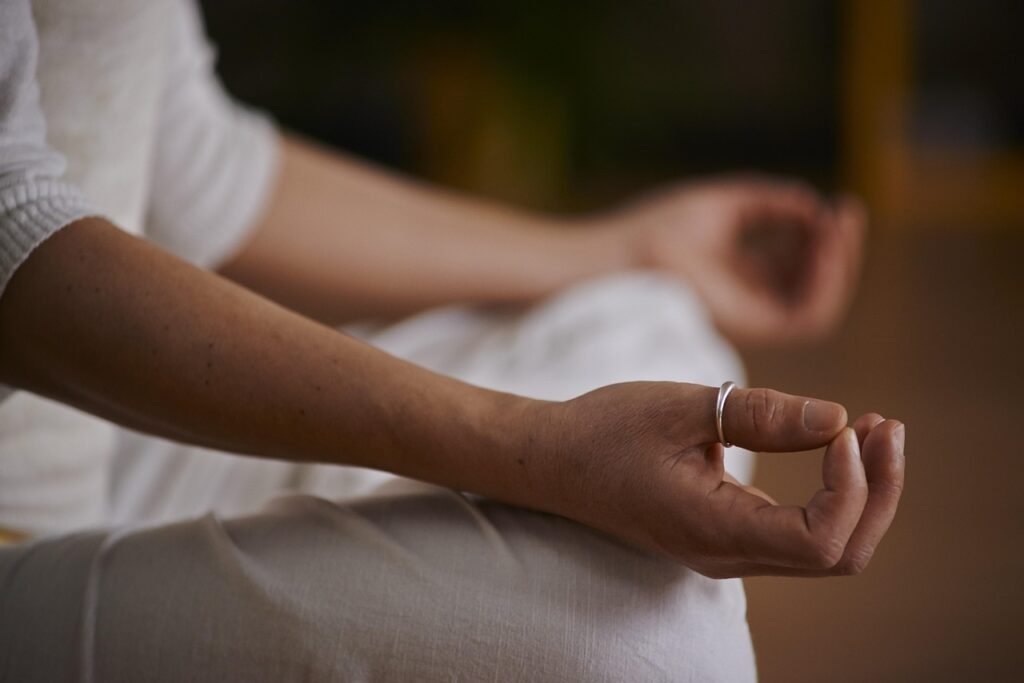The morning alarm blares. Before your feet even hit the floor, your mind is already racing—emails to answer, a project deadline looming, kids to get ready for school, an appointment you can’t miss. It feels like you’re running a marathon from the moment you wake up until your head finally hits the pillow. In this relentless cycle of “doing,” we often lose the simple art of “being.” The result? A persistent hum of stress, a scattered mind, and a feeling of being disconnected from our own lives.
But what if you could find a pocket of calm in the storm? What if you could reclaim your focus and composure, not by adding another monumental task to your to-do list, but by dedicating just 10 minutes a day to a simple, transformative practice?
This is the promise of mindfulness—the practice of paying attention to the present moment, on purpose, without judgment. It’s not about stopping your thoughts or achieving a state of eternal bliss. It’s about changing your relationship with your thoughts, feelings, and the world around you. This guide will not only show you how with ten simple practices but also explain the science behind why it works, turning a seemingly small 10-minute investment into your most powerful tool for navigating a busy life.

Table of Contents
The Surprising Power of a 10-Minute Pause: The Science Behind the Calm
Mindfulness isn’t just a wellness trend; it’s a form of mental training backed by a growing body of neuroscience. When you practice mindfulness, you are literally reshaping your brain for the better.
Taming Your Brain’s Alarm System
Your brain has a built-in alarm system called the amygdala, responsible for the “fight-or-flight” response. In our modern world, this alarm is often triggered by non-life-threatening stressors like a critical email or traffic jam. Studies have shown that consistent mindfulness practice can actually shrink the amygdala. This means you become less reactive to stress; the alarm doesn’t go off as easily, giving you more space to respond thoughtfully instead of instinctively.
Building Your Focus Muscle
The prefrontal cortex, located behind your forehead, is the hub of higher-order thinking: concentration, decision-making, and self-awareness. Think of it as your brain’s CEO. Mindfulness practice, especially focusing on an anchor like the breath, strengthens the neural connections in this area. It’s like taking your brain to the gym. A stronger prefrontal cortex means better focus, less mind-wandering, and improved clarity.
Neuroplasticity: Rewiring Your Brain for Peace
For a long time, it was believed the adult brain was fixed. We now know about neuroplasticity—the brain’s remarkable ability to reorganize itself by forming new neural connections throughout life. Every time you consciously bring your attention back to the present moment, you are carving out a new neural pathway for calmness and awareness, making it the brain’s new default over time.
10 Beginner-Friendly Mindfulness Practices (Expanded and Detailed)
Here are ten practical mindfulness exercises, now with more detailed guidance, troubleshooting tips, and explanations for why they are perfect for a packed schedule.
1. Foundational Mindful Breathing
This is the cornerstone of mindfulness. It’s simple, free, and can be done anywhere.
- How to Practice (Expanded):
- Find a comfortable, stable position, either sitting on a chair with your feet flat on the floor or lying down.
- Gently close your eyes or soften your gaze, looking down a few feet in front of you.
- Begin by taking three slow, deep breaths. Inhale through your nose, filling your belly with air, and exhale slowly through your mouth.
- Now, let your breath return to its natural rhythm. Don’t try to control it.
- Place your attention on the physical sensation of breathing. You might notice the coolness of the air entering your nostrils, the slight tickle in your throat, or the gentle rise and fall of your chest and abdomen. Choose one spot to be your anchor.
- Your mind will wander. This is normal and expected. When you notice your mind has drifted to a thought, a worry, or a sound, gently acknowledge it (“thinking”) and then compassionately guide your attention back to your anchor—the sensation of your breath.
- Why it Works for Busy People: It directly counteracts the physiological stress response in real-time, making it a perfect “reset button” between meetings or after a difficult conversation.
- Troubleshooting & Tips:
- Feel like you can’t breathe right? You’re not trying to achieve a “special” breath. Just observe whatever breath is present.
- Try “Box Breathing”: For extra focus, inhale for a count of 4, hold for 4, exhale for 4, and hold for 4. Repeat. This is a technique used by Navy SEALs to stay calm under pressure.
2. The Full Body Scan Meditation
This practice reconnects your mind with your body, helping to release stored tension.
- How to Practice (Expanded):
- Lie down comfortably on your back, legs uncrossed, arms resting by your sides with palms facing up.
- Bring your awareness to the toes of your left foot. Notice any sensations—tingling, warmth, pressure from a sock—without needing to change anything.
- Slowly, like a gentle spotlight, move your awareness up your left foot to the ankle, calf, and knee, then the thigh. Spend a moment with each part, just noticing.
- Repeat the entire process with your right leg, from the toes to the hip.
- Continue this scan up through your pelvis, abdomen, lower back, chest, and upper back. Then scan down both arms to your fingertips. Finally, scan your neck, face, and the top of your head.
- Why it Works for Busy People: We live in our heads. This practice grounds you in your physical self, providing an antidote to mental overload and helping to identify and release physical tension you didn’t even know you were carrying.
- Troubleshooting & Tips:
- Falling asleep? That’s okay! It means you’re relaxed. If you need to stay awake, try doing the practice while sitting in a chair.
- Feeling impatient? Notice the impatience itself as just another sensation. Where do you feel it in your body? Then gently return to the scan.
3. Mindful Listening (The 360° Soundscape)
Turn the noise of your world into a point of focus.
- How to Practice: Sit comfortably and allow your ears to be wide open. First, notice the most obvious sounds. Then, listen for the more subtle sounds—the hum of a refrigerator, a distant bird, the sound of your own breathing. Finally, listen for the sound of silence itself underneath it all. Acknowledge each sound without judgment or analysis.
- Why it Works for Busy People: It transforms annoying or distracting environments (like an open office or a busy street) into an opportunity for practice, rather than an obstacle.
- Troubleshooting & Tips: If a sound is particularly irritating, try to get curious about its qualities—its pitch, its rhythm, its volume—instead of layering on the story of “I hate that noise.”

4. Mindful Walking (From A to B)
Turn any necessary movement into a meditation.
- How to Practice: As you walk from your car to your office, or just to the kitchen, bring your full attention to the act of walking. Notice the sensation of your feet lifting and landing on the ground. Feel the movement in your legs and the gentle swing of your arms. Are you rushing? Can you walk at a natural, unhurried pace?
- Why it Works for Busy People: It requires no extra time. You have to walk anyway; this simply changes the quality of your attention during the activity.
- Troubleshooting & Tips: Don’t worry about looking strange. To an outsider, you’re just walking. This is an entirely internal practice.
5. Mindful Eating (The First Five Bites)
Transform your relationship with food and mindless consumption.
- How to Practice: You don’t have to eat a whole meal mindfully at first. Commit to the first five bites of your lunch. Before the first bite, look at your food: notice the colors, shapes, and smells. For each of the first five mouthfuls, chew slowly. Put your fork down between bites. Try to identify all the different flavors. Notice the texture.
- Why it Works for Busy People: It combats desk-side, rushed eating, improving digestion and increasing satisfaction from your meal, which can reduce cravings later.
- Troubleshooting & Tips: This can feel awkward at first, especially if you’re eating with others. Just focus on your own experience. No one will notice if you chew a little more slowly.

6. The 5-4-3-2-1 Grounding Exercise
A powerful “emergency brake” for moments of high anxiety or overwhelm.
- How to Practice: Wherever you are, pause and silently name:
- 5 things you can see. (Your computer monitor, a crack in the wall, the color blue on a book spine…)
- 4 things you can feel. (The texture of your shirt, the firmness of the chair, the cool surface of the desk, your feet on the floor…)
- 3 things you can hear. (The hum of the air conditioner, a distant car horn, the sound of your own breathing…)
- 2 things you can smell. (The faint scent of coffee, the soap on your hands…)
- 1 thing you can taste. (The lingering taste of toothpaste or your last drink of water…)
- Why it Works for Busy People: It takes less than two minutes and immediately pulls your mind out of a catastrophic thought loop and into the tangible, real-world present.
- Troubleshooting & Tips: If you can’t find two things to smell or one to taste, don’t worry. Just imagine a pleasant smell or taste. The point is to engage your senses.
7. Loving-Kindness Meditation
A practice to cultivate compassion for yourself and others, especially when you’re feeling critical or irritable.
- How to Practice: Sit quietly and bring to mind a person or pet who you love easily. Picture them and silently repeat: “May you be happy. May you be healthy. May you be safe. May you live with ease.” After a few minutes, turn this warmth and kindness toward yourself, repeating the same phrases. Then, extend it to a neutral person (like a cashier), a difficult person, and finally, all beings everywhere.
- Why it Works for Busy People: Stress can make us short-tempered and self-critical. This practice is a direct antidote, softening our hearts and improving our relationships.
- Troubleshooting & Tips: Feeling nothing or feeling inauthentic is common. Just think of it as planting seeds. You don’t have to feel it for the intention to have an effect. If focusing on a difficult person is too much, skip that step for now.
8. Mindful Observation (The Coffee Cup Meditation)
Cultivate a sense of wonder in the mundane.
- How to Practice: Pick up a regular object—your coffee mug, a pen, your houseplant. Look at it as if you’ve never seen it before. Notice the play of light and shadow on its surface. Observe its texture, its weight, its exact shade of color.
- Why it Works for Busy People: It trains your attention and helps you find moments of beauty and interest in an environment you might otherwise find boring or stressful.
- Troubleshooting & Tips: Your mind will try to label it (“It’s a blue pen”). Gently move past the label to the raw sensory data—the specific hue of blue, the reflection on the plastic, etc.
9. The Gratitude Practice
Shift your brain’s natural negativity bias.
- How to Practice: Take just two minutes to write down or mentally list three specific things you are grateful for right now. Be specific. Not just “my family,” but “the way my daughter laughed this morning.” Not just “my job,” but “the satisfaction of completing that one specific task.”
- Why it Works for Busy People: It’s a quick, powerful mood-booster that shifts your perspective from what’s wrong to what’s right, building resilience against daily frustrations.
- Troubleshooting & Tips: If you’re struggling, think small. The warmth of your socks. The first sip of coffee. The fact that the internet is working.
10. Mindful Micro-Pauses
Integrate mindfulness into the flow of your day in one-minute increments.
- How to Practice: Set a recurring, silent alarm on your phone for three times a day. When it goes off, stop what you are doing. Take one mindful breath. Notice your posture. Feel your feet on the floor. Then, resume your task.
- Why it Works for Busy People: It breaks the spell of hypnotic, non-stop work, preventing burnout by creating tiny pockets of restoration throughout the day, rather than waiting until you’re completely drained.
- Troubleshooting & Tips: Link these pauses to an existing habit (a “habit stack”). For example: “After I hang up the phone from a call, I will take one mindful breath.”
Weaving Mindfulness into the Fabric of Your Busy Life
- Schedule It Like a CEO: You schedule meetings and appointments. Schedule 10 minutes of “mindful time” into your calendar. Protect it like you would a meeting with your most important client—because you are.
- The Power of Habit Stacking: Link your new mindfulness practice to an existing daily habit. For example: “After I brush my teeth, I will do a 5-minute body scan.” Or “While the coffee is brewing, I will practice mindful listening.”
- Overcoming Resistance: Your mind will come up with excuses: “I’m too tired,” “It’s not working,” “This is silly.” Acknowledge these thoughts as resistance, and do the practice anyway—even for just two minutes. The biggest hurdle is getting started.
- Leverage Technology Wisely: Apps like Calm, Headspace, or Insight Timer offer thousands of guided meditations. Use them as a support, but don’t become dependent. The ultimate goal is to learn to guide yourself.
Frequently Asked Questions (FAQ) about Mindfulness
Q: Do I need to sit in a special position or chant?
A: No. While a straight spine can help with alertness, you can practice mindfulness sitting in an office chair, lying down, or walking. There is no religious component required unless you want there to be.
Q: My mind is too busy, I can’t stop my thoughts!
A: That’s the most common misconception. Mindfulness is not about stopping your thoughts; it’s about noticing that you are thinking. The goal is to observe the thoughts without getting swept away by them. Every time you notice your mind has wandered and you gently bring it back, that is a moment of successful mindfulness.
Q: Is this the same as relaxation?
A: Relaxation is often a wonderful side effect of mindfulness, but it’s not the goal. The goal is awareness. Sometimes, being aware means noticing feelings of restlessness or sadness, and learning to be with them without judgment.
Q: How long until I see results?
A: You may feel calmer immediately after a 10-minute practice. The deeper, lasting benefits, like reduced reactivity and improved focus, come from consistency over weeks and months. It’s a practice, not a quick fix.
Conclusion: Your Journey Starts with a Single Breath
You don’t need to quit your job, move to a monastery, or overhaul your entire life to find peace. Peace exists in the small moments you are already living. By incorporating these simple 10-minute practices, you are not adding another burden to your schedule. You are transforming the quality of the time you already have. You are learning to be the calm center in the ever-spinning wheel of your busy life.
Your journey to a more present, peaceful, and focused life doesn’t start tomorrow or next week. It starts right now, with your very next breath.
Ready to reclaim your calm? Choose just ONE practice from this list that feels most approachable to you. Commit to trying it for 10 minutes every day for the next seven days. Share which practice you chose in the comments below and let us know how it goes!